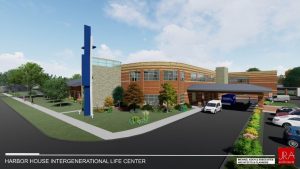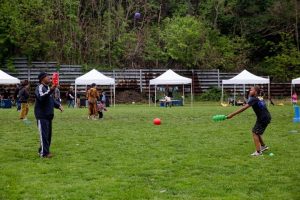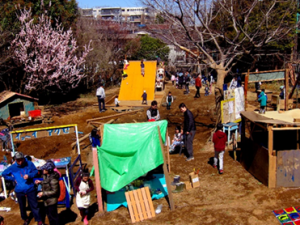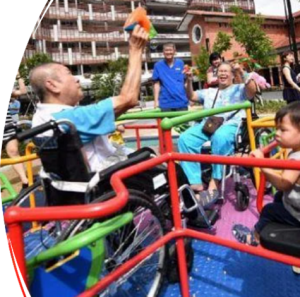Sign up to receive future issues of this newsletter – select Shared Site Learning Network (Quarterly Alerts and Information on Resources and Training)
“We don’t stop playing because we grow older; we grow older because we stop playing.”
This Intergenerational Shared Site Network issue focuses on creating intergenerational play spaces that foster cross-age connection, creativity, and learning. In addition to being fun, play provides people of all ages with social, emotional, and physical benefits, promotes empathy, and combats ageist stereotypes. The opportunities for designing and/or enriching intergenerational playful environments are endless.
To learn more about intergenerational play, check out the recording and materials from our March 7, 2024 webinar Play for All Ages: Designing Intergenerational Spaces That Build Connections and Encourage Learning.
Table of Contents
- Program Highlight
- Resources
- Promising Practices
- In the News
Program Highlight
Harbor House Intergenerational Life Center
Harbor House’s Intergenerational Life Center (ILC) is a place where individuals of all ages, abilities, and socioeconomic statuses are welcome to learn, grow, & lead more fulfilling lives. At this new 36,000-square-foot facility, adults with disabilities, older adults, and children come together to foster mutually beneficial relationships in a home away from home setting. The Center offers a wide variety of programs and services, including adult day training that provides life skills activities (e.g. daily living skills, communication, budgeting, learning to count money, learning to write, learning computer skills), a drop-in program for teens with disabilities, and before and after school child care.
welcome to learn, grow, & lead more fulfilling lives. At this new 36,000-square-foot facility, adults with disabilities, older adults, and children come together to foster mutually beneficial relationships in a home away from home setting. The Center offers a wide variety of programs and services, including adult day training that provides life skills activities (e.g. daily living skills, communication, budgeting, learning to count money, learning to write, learning computer skills), a drop-in program for teens with disabilities, and before and after school child care.
Inside the new building is a great room, gallery/gift shop. bathing spa, cafe/coffee shop, commercial kitchen, computer lab, game room, music, dance, and art studios, beauty salon, on-site pharmacy, and medical center. Once the ILC is completed, work will begin on transforming the current facility into a Child Enrichment Center. The new center, which will accommodate 94 children of all abilities from 6 weeks to school age, will be completed in the summer of 2025. A covered walkway will connect the Child Enrichment Center and the Intergenerational Life Center. Other outdoor spaces that will be used to promote cross-age connection will include a courtyard with places to sit and large games (e.g. Jenga, Connect 4), a music garden, a greenhouse, and nature-based playgrounds.
For more information, contact Maria Smith msmith@hhlou.org or Karen Fallon kfallon@hhlou.org .
Resources
Playful Learning Creates Multi-Generational Opportunities with Intergenerational Impacts
Play is an integral part of children’s learning and development. While it generally evokes a picture of a small child running, jumping, and shouting, play’s benefits in promoting early development and better health outcomes extend far beyond childhood. In fact, playful learning—an area of research that examines how children learn best through playful exchanges—shares many of the same core foundations as the study of intergenerational learning—a body of research involving older and younger generations coming together to provide mutually beneficial learning experiences. Read more.
Play is not only beneficial but essential for people of all ages. Today, there is increasing interest in the benefits of not only play itself, but specifically people from younger and older generations playing together. The built environment in our communities plays a critical role in facilitating this intergenerational engagement and play. Approaches such as Intergenerational Contact Zones (ICZs) introduce strategies for promoting social inclusion and belonging, employing novel planning and designing public spaces to create intergenerationally enriched environments. Read more. Access the recording here.
Intergenerational Playgrounds Unite the Young and Old
China is believed to have led the way in developing multigenerational playgrounds, adopting a national law that resulted in a nationwide physical fitness program for elderly citizens. The idea took hold quickly. After spreading across Asia and Europe (Spain has more than 600 models), playgrounds for seniors began popping up in the United States, taking on an intergenerational focus. They first appeared in cities such as Tampa, Portland, Boston, Washington D.C., and San Diego, often in economically challenged neighborhoods or areas where retirement centers were close to subdivisions. Read more.
The Story Behind Intergenerational Play: Playful Pittsburg Collaborative
The term intergenerational is often defined as a purposeful, regular exchange and learning between children and older people. This intergenerational sharing can bridge generational differences and provide mutual benefits, as well as counteract ageism and age-related stereotypes. Play is not only beneficial but essential for people of all ages. Today, there is increasing interest in the benefits of not only play itself but specifically people from younger and older generations playing together. Read more.
older people. This intergenerational sharing can bridge generational differences and provide mutual benefits, as well as counteract ageism and age-related stereotypes. Play is not only beneficial but essential for people of all ages. Today, there is increasing interest in the benefits of not only play itself but specifically people from younger and older generations playing together. Read more.
Playful Learning Landscapes Action Network
Playful Learning Landscapes Action Network infuses the best science of learning into initiatives to build strong cities, offering exciting opportunities to help all children reach their potential. In cities around the world, everyday public places are being transformed – bus stops, libraries, parks – into hubs of playful learning. Working with communities, we can build on their strengths to co-create playful learning opportunities where they are needed most. Read more.
The Power of Playful Learning in the Early Childhood Setting
Play versus learning represents a false dichotomy in education (e.g., Hirsh-Pasek & Golinkoff 2008). In part, the persistent belief that learning must be rigid and teacher-directed—the opposite of play—is motivated by the lack of a clear definition of what constitutes playful learning (Zosh et al., 2018). And, in part, it is motivated by older perceptions of play and learning. Newer research, however, allows us to reframe the debate as learning via play—as playful learning. Read more.
Together: Design Guidelines for Intergenerational Playgrounds
Play is done for joy, as an escape from everyday activities. Not only is play fun, but it also provides of all ages with social, emotional, and physical benefits that can last for a lifetime (Rainwater, 1922; Gray, 2017). Playgrounds are a facilitator for play, allowing users to participate in various activities that encourage an active lifestyle and mental wellness (Frost,2009). In the United States, however, public playgrounds are typically designed for specific age groups. The compartmentalization of playgrounds by age group separates users of different generations. Yet, intergenerational connections are essential for strong social equity in communities. Read more.
The Tokyo Playpark: A Landscape for all Ages
These days cities offer only limited opportunity for spontaneous contact between generations. We seem to keep reinventing new versions of the same age-segregated modernist city that architect Lewis Mumford argued against in his seminal 1949 article, where he plead for “planning for all phases of life”. In an age-segregated city, intergenerational contact often only happens through activity programs or single events whose goal is to bring together age groups that are structurally kept apart, such as children and older adults. An alternative approach to intergenerational contact is evident in the Tokyo Playpark Movement, which we discovered when searching for architectural solutions to include older adults in public spaces. Here we found a landscape of spontaneous community participation. Read more.
in his seminal 1949 article, where he plead for “planning for all phases of life”. In an age-segregated city, intergenerational contact often only happens through activity programs or single events whose goal is to bring together age groups that are structurally kept apart, such as children and older adults. An alternative approach to intergenerational contact is evident in the Tokyo Playpark Movement, which we discovered when searching for architectural solutions to include older adults in public spaces. Here we found a landscape of spontaneous community participation. Read more.
Promising Practices
Playful Learning Practices
A pedagogy of play involves bringing play and playfulness into many aspects of school life: teaching, learning, assessment, the classroom environment, and school culture. Five core practices and associated teaching strategies that promote cultures of playful learning in classrooms and schools are discussed. Read more.
Playful Learning Playbook
This Playbook is an introduction to playful learning for anyone interested in combining play and learning in a community setting: community leaders, organizations working in education, play, or youth development, members of city government, or architects, designers, and innovators with an interest in building playful learning into their environments. Read more.
Intergenerational Engagement
Strategies are offered to build a strong foundation for all types of intergenerational programming. These strategies come from discussions held as part of the Intergenerational Engagement Community of Practice discussions which included participation from intergenerational programming experts, service delivery experts, and researchers. Read more.
Intergenerational Contact Zones
In their book, Intergenerational Contact Zones: Place-based Strategies for Promoting Social Inclusion and Belonging, Kaplan, Thang, Sánchez, and Hoffman introduce novel ways of thinking, planning, and designing intergenerationally enriched environments. Filled with vivid examples of how ICZs breathe new life into communities and social practices, this important volume focuses on practical descriptions of ways in which practitioners and researchers could translate and infuse the notion of ICZ into their work. Read more.
Learn more about the 16 feasibility criteria developed for the designation of Intergenerational Contact Zones.
In the News
Familiar Board Games get an Intergenerational Refresh
Odds are, you played The Game of Life as a kid and Trivial Pursuit when that board game hit the shelves in 1981 but haven’t rolled the dice with either one since. New versions — reinvented for older adults to compete against their grown children and grandkids — might get you back. Read more.
National Building Museum Opens New Multi-generational Exhibit
Building Stories is a new long-term exhibition that brings kids and adults alike on an immersive exploration of the world of architecture, engineering, construction, and design found in the pages of children’s books. Occupying 4,000 square feet of prominent exhibition space on the Museum’s ground floor, Building Stories is the most ambitious exhibition ever undertaken by the Museum and will be on display for ten years. Read more.
Intergenerational Care Facility Incentive Grant Program
The creation of on-site child care services in some of Nebraska’s assisted living communities as well as nursing homes would be incentivized under a proposed bill. LB 1178, establishing the Intergenerational Care Facility Incentive Grant Program, would provide one-time startup grants of up to $100,000 to facilities certified for Medicare or Medicaid. Communities could use the grants for structural updates, outside campus space, equipment, and supplies. Read more.
National Parks and Recreation Association Receives Grant from RRF
The National Recreation and Park Association (NRPA), the nation’s leading advocate for parks and recreation, is proud to announce the receipt of funding to support the organization’s Healthy Aging in Parks initiative, grounded in research. With support from RRF Foundation for Aging, NRPA is tapping into the power of parks and recreation to support aging in place, foster social connection, and combat the epidemic of loneliness and isolation among older adults. Read more.
This newsletter is presented as part of Generations United’s Shared Site Learning Network which is made possible with support from The Eisner Foundation.
